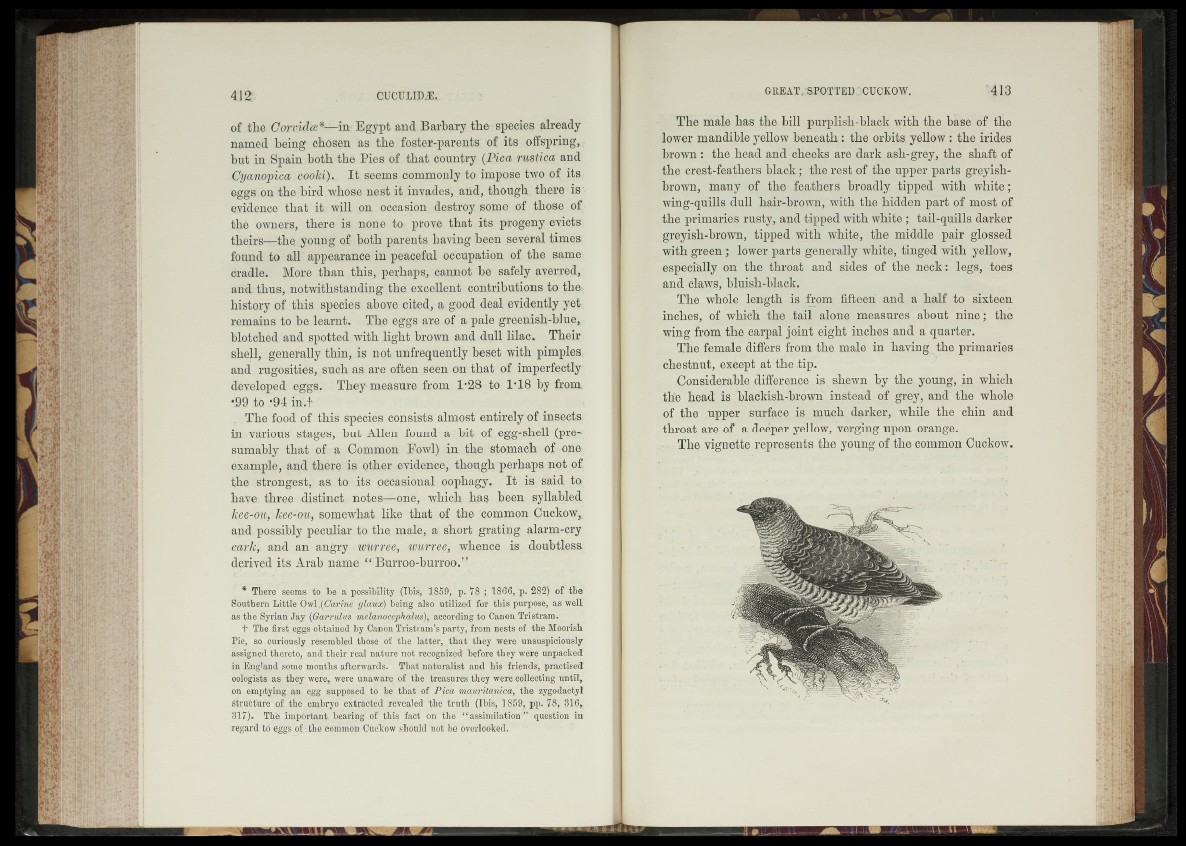
of thé Corvidte*—in Egypt and Barbary the species already
named being chosen as the foster-parents of its offsprings
but in Spain both the Pies of that country (Pica rustica and
Cycinopica cooki). It seems commonly to impose two of its
eggs on the bird whose nest it invades, and, though there is
evidence that it will on occasion destroy some of those of
the owners, there is none to prove that its progeny evicts
theirs—the, young of both parents having been several times
found to all appearance in peaceful occupation of the same
cradle. More than this, perhaps, cannot be safely averred,
and thus, notwithstanding the excellent contributions to the;
history of this species above cited, a good deal evidently yet
remains to be learnt. The eggs are of a pale greenish-blue,
blotched and spotted with light brown and dull lilac. Their
shell, generally thin, is not unfrequently beset with pimples
and rugosities, such as are often seen on that of imperfectly
developed eggs. They- measure from 1*28 to 1*18 by from,
*99 to *94 in.f
. The food of this species consists almost entirely of insects
in various stages, but Allen found a bit of egg-shell (presumably
that of a Common Fowl) in the stomach of one/
example, and there is other evidence, though perhaps not of
the strongest, as to its occasional oophagy. It is said to
have three distinct notes—one, which has been syllabled
kee-ou, kee-ou, somewhat like that of the common Cuckow,
and possibly peculiar to the, male, a short grating alarm-cry
cark, and an angry wurree, wurree, whence is doubtless:
derived its Arab name “ Burroo-burroo.”
* There seems to he a possibility (Ibis, 1859, p. 78 ; 1866, p. 282) of the
Southern Little Owl JCarine glaux) being also utilized for this purpose, as well
as the Syrian Jay (Oarrulus melanocephalus), according to Canon Tristram.
*t The first eggs obtained by Canon Tristram’s party, from nests of the Moorish
Pie, so curiously resembled those of the latter, that they were unsuspiciously
assigned thereto, and their real nature not recognized before they were unpacked
in. England some months afterwards. That naturalist and his friends, practised
oologists as they were, were unaware of the treasures they were collecting until,
on emptying an egg supposed to be that of Pica mauritanica, the zygodactyl
structure of the embryo extracted revealed the truth (Ibis, 1859, pp. 78, 316,.
317). The important bearing of this fact on the “ assimilation” question in
regard to eggS of: the common Cuckow should not be overlooked.
THe male has the bill purplish-black with the base of the
lower mandible yellow beneath : the orbits yellow : the irides
brown : the head and cheeks are dark ash-grey, the shaft of
the crest-feathers black; the rest of the upper parts greyish-
brown, many of the feathers broadly tipped with white;
wing-quills dull hair-brown, with the hidden part of most of
the primaries rusty, and tipped with white ; tail-quills darker
greyish-brown, tipped with white, the middle pair glossed
with green ; lower parts generally white, tinged with yellow,
especially on the throat and sides of the neck: legs, toes
and claws, bluish-black.
The whole length- is from fifteen and a half to sixteen
inches, of which the tail alone measures about nine; the
wing from the carpal joint eight inches and a quarter.
The female differs from the male in having the primaries
chestnut, except at the .tip.
Considerable difference is shewn by the young, in which
the head is blackish-brown instead of grey, and the whole
of the upper surface is much darker, while the chin and
throat are of a deeper yellow, verging upon orange.
The vignette represents the young of the common Cuckow.
1 4 4 -4 1 -A